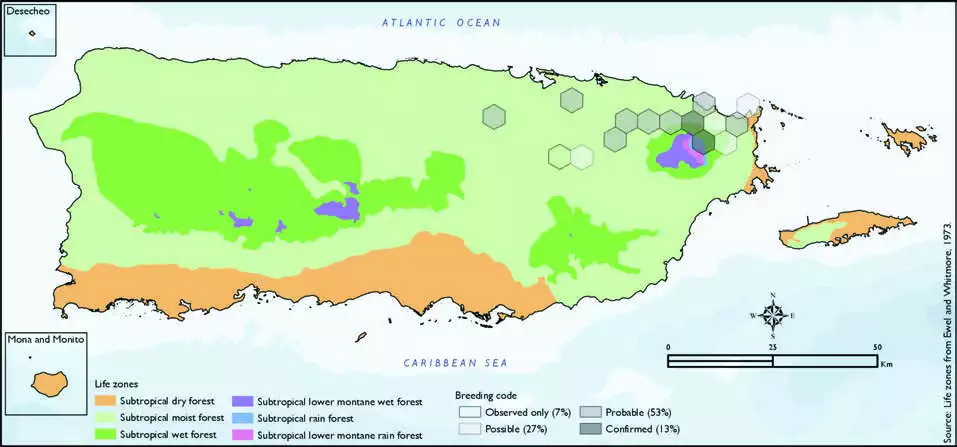Orange-fronted Parakeet
Description
The orange-fronted parakeet or orange-fronted conure (Eupsittula canicularis), also known as the half-moon conure, is a medium-sized parrot that is resident from western Mexico to Costa Rica.
Orange-fronted parakeets are 22.5 cm (8.9 in) long and weigh 80 g (2.8 oz). The adult is mainly green, paler and yellower below and with an olive tone to the breast. The wings have blue outer primaries and yellow linings, and the pointed tail is tipped with blue. The head is distinctive, with a blue crown, orange forehead, bare yellow eye-ring, yellow iris and white bill. Young birds are similar to the adults, but with much less orange on the forehead.
Distribution & Habitat
The Orange-fronted Parakeet is native to Mexico and Central
America (Raffaele and others
1998). It was introduced to
Puerto Rico, where it is locally
uncommon from Cabezas de
San Juan near Fajardo (Raffaele
and others 1998) and scattered
throughout the Fajardo Christmas
Bird Count circle (Wunderle, Jr.
2017) and nearby (Falcón and
Tremblay 2018). In Puerto Rico,
the species usually inhabits
wooded pastures and urban
areas with ornamental trees
(Raffaele and others 1998).
However, in its native habitat
it occurs mostly in tropical
deciduous and semideciduous forests, lower cloud forests,
agricultural areas, disturbed
areas, mango plantations,
coconut palms, and fl at coastal
plains (Hardy 1965, Navarro
1994). The atlas fieldwork
yielded a total of 22 records
within 15 hexagons or 3 percent
of the 479 total hexagons (see
map). Of the 15 hexagons where
the Orange-fronted Parakeet was
found, breeding met the atlas
definition of confirmed in 13
percent (two) of the hexagons,
probable in 53 percent (eight),
and possible in 27 percent (four),
while the species was observed
in 7 percent (one) of the
hexagons but without evidence
of breeding (see map). Orange-fronted Parakeet distribution. The map shows the highest breeding code by hexagon and overlaying the ecological life
zones in Puerto Rico. Note: percentages may not total 100 due to rounding. 189Orange-fronted Parakeet/Periquito Frentianaranjado

Breeding Habits
The Orange-fronted Parakeets nest has not yet been found on
Puerto Rico (Raffaele and others
1998). However, it may excavate
nest holes in arboreal termitaria
(Sazima 1989). Atlas results
suggest that this species breeds
from February to July and to a
lesser extent during December
(see chart). Overall, the breeding
activity peaks in March, and it
mostly takes place within the
subtropical moist forest life
zone (see chart). Atlas results show that this species breeds
mostly within the subtropical
moist forest life zone (79 percent
of the hexagons) (see table
and map). It also breeds in
subtropical rain forest life zones
at higher elevations (7 percent of
the hexagons).
Conservation
The Orange-fronted Parakeet is currently listed as a species
of least concern by the
IUCN (BirdLife International
2018), while in Puerto Rico this parakeet has increased
in population size and has
expanded in range (Falcón and
Tremblay 2018). Locally, this
species is not listed in any of the
threatened categories of PRDNER
and USFWS.In Puerto Rico, the Orange-fronted Parakeet has a protected
habitat in land of 14 percent or
46 km2 of the total area covered by the hexagons where evidence
of breeding was found for this
species (334 km2).
Related Species
Family:
parakeet